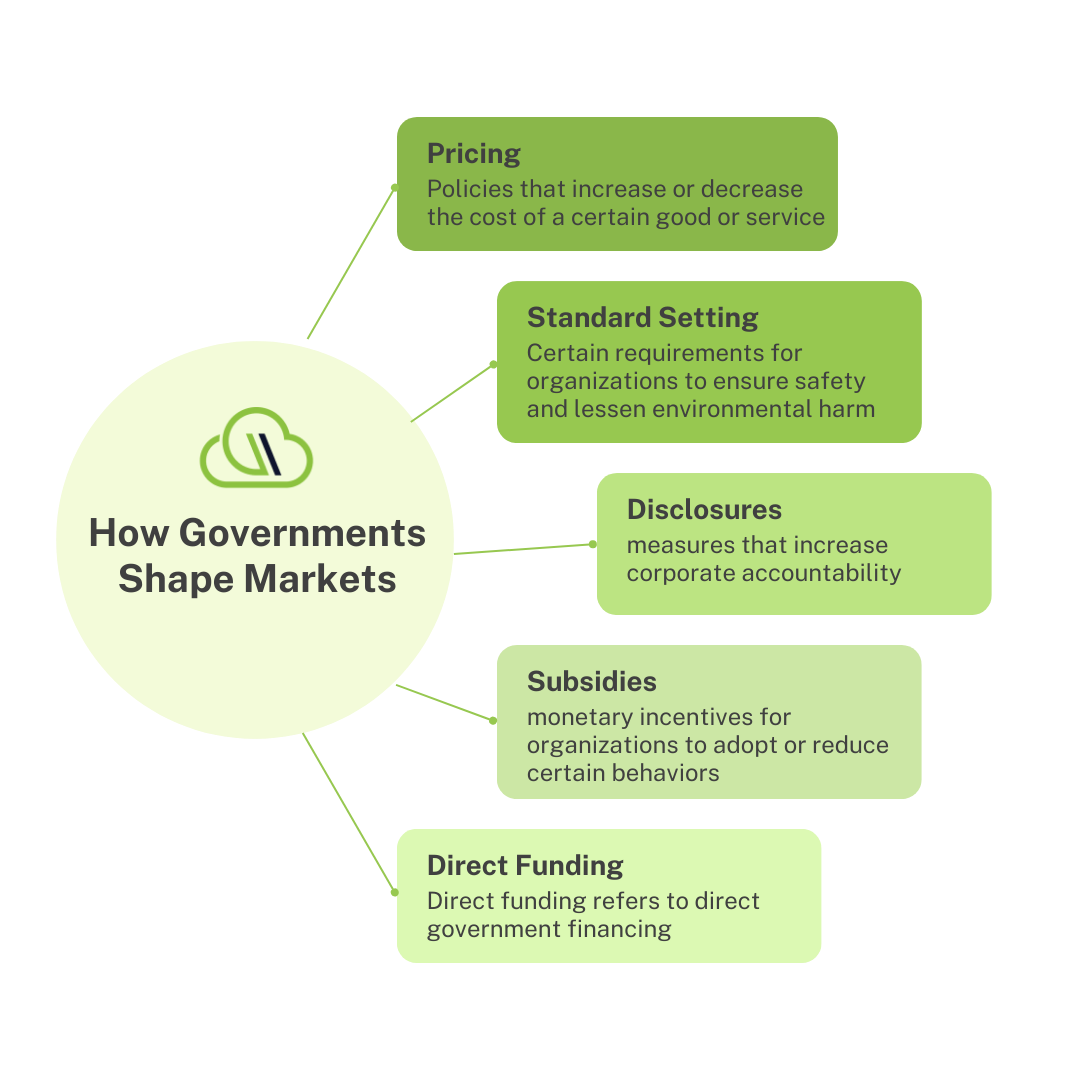As governments, businesses, and consumers alike work to respond to climate change, it can feel as though the best practices and policies are constantly changing. Understanding and navigating policy changes will be a differentiating factor in long-term business survival. While we can’t predict the future, there are steps every visionary leader should take to prepare their organization to weather the ups and downs of climate policy changes and their market effects.
How Governments Shape Markets
To understand how to respond to policy change, a leader must first understand how policy can influence markets and the effects of each type. Governmental policy can influence the environmental impact of business markets in 5 ways.
Pricing
Pricing measures are policies that increase or decrease the cost of a certain good or service. An example is a carbon tax, which increases the cost of producing carbon-intensive goods or services.
Standard Setting
Standard setting places certain requirements upon organizations to ensure safety and lessen environmental harm. For example, the Renewable Fuel Standard program, which is “a national policy that requires a certain volume of renewable fuel be used to replace or reduce the quantity of fossil fuel in transportation fuel, home heating oil, or jet fuel” (EPA).
Disclosures and Regulations
Governmental regulations are laws that control or impact the way businesses operate. With governments around the world committing to climate change initiatives, there has also been an uptick in ESG-related regulations. Our guide to ESG regulations provides a more detailed look at the regulatory landscape in the USA. For the EMEA region, check out this resource.
Disclosures are measures that increase corporate accountability. While they are non-governmental, disclosure frameworks often heavily influence governmental regulations and policies. ESG disclosures are a big focus for businesses right now, including disclosure frameworks such as GRI, CDP, and more. Check out our guide to ESG disclosure frameworks for more details.
Subsidies
Subsidies are monetary incentives for organizations to adopt or reduce certain behaviors. For example, the Inflation Reduction Act (IRA) provided financial incentives to promote the deployment of low-emission or no-emission technologies.
Direct Funding
Direct funding refers to direct government financing. For example, government investment in renewable energy production.

Don’t React, Anticipate
Change is inevitable, but the leaders who can stay ahead of the ESG curve will reap the biggest rewards. Policy changes will continue to facilitate or impede global supply chains as governments around the globe continue to come to terms with the effects of climate change. Those who can enable their customers and suppliers to overcome transition barriers as these changes take effect will not only survive the shift but capitalize on it.
Policy-driven markets will become golden opportunities for those with foresight, as other participants fail to anticipate or adapt to new sources of green demand. The key is anticipating how policy may influence the dynamics of your industry to not only manage uncertainty but also to harness new opportunities as they are presented.
So How Can Savvy CEOs Stay Ahead of Policy Changes?
Stay Alert to Sectoral Governmental Policy Proposals
Ensure that you are aware of any potential policies before they become implemented. How your organization monitors this may vary. Examples could range anywhere from creating an alert for keywords that would indicate policy changes on the horizon for your industry to hiring a resource to monitor and engage with governmental policies on your company’s behalf.
Companies looking to stay at the cutting edge of ESG may take a step further, ensuring that their corporate affairs team is knowledgeable about critical sectors with the potential for future value creation. Working with governments to overcome transition barriers will be another key step in influencing industry standards and gaining competitive advantages from investing in early-stage technology.
Invest in Low-Carbon Supply Chains and Technology
The easiest way to stay agile in the world of ESG is to adapt before regulations make it necessary. Investing in low-carbon supply chains and route optimization will help decrease your organization’s carbon footprint significantly, as supply chain emissions average 5.5 times greater than a company’s direct emissions, according to a study by the CDP.
Adopting low-carbon technology is another way to stay ahead of ESG regulations and reap sustainability benefits. Low-carbon technologies increase the ratio of available resources, decrease the primary demand for production factors, better utilize inevitable emissions more efficiently, or convert desired products from renewable resources. Examples include digitized facility management, carbon capture and utilization, or geothermal heating. These technologies are important to invest in because they will have a longer utilization timeline in a world that is shifting to favor low-carbon options, increase efficiency, and reduce waste.
The Bottom Line
ESG can create opportunities for competitive advantages for agile CEOs who adapt early as technology and industry standards shift to accommodate climate change. Those with the foresight to adjust their strategies and investments before sectoral ESG policy solidifies will be better equipped to thrive through the changes and influence the new landscape.